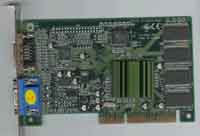The Card
Since video chipset manufacturers usually offer up reference board designs, and motherboard chipset manufacturers don't, it stands to reason that designing a video card is a lot easier than a motherboard. This is apparent in Gainward's strict use of an S3 Savage4 reference PCB design. This keeps costs down by reducing engineering costs. And in this case, the reference design make efficient use of space, which further cuts down on costs.
The board itself is just long enough to fit in an AGP slot, so there's no need to worry about interference from tall motherboard components. AnandTech's sample featured S3's 86C397 Savage4 Pro backed up by 32MB of 8ns/125MHz MIRA SDRAM. The Savage4 chip itself is adorned with an interesting green heatsink - one that's actually fairly common on Gainward graphics cards. It is sort of a semicircle in shape and does a good job of cooling the Savage4 Pro, allowing it to overclock stabily to 135/135 for about a 20% increase in performance.
There has been some confusion regarding the clock speed of the various Savage 4 versions, even by us here at AnandTech. This was recently cleared up by Paul Crossley of S3 in an e-mail sent to Sharky Extreme. What it comes down to is that the Savage4 Pro is spec'ed at 110/125MHz (core/memory). The Savage4 Pro Plus is the chip used on the Diamond Stealth III S540 and is intended to be clocked at 125/143. The 86C397 on the CARDEXpert SG4 AnandTech received is clocked as S3 says it should be - at 110/125. Gainward also offers models based on all available variations of the Savage4 chipset. Expect everything except the exact performance numbers and overclocking results to apply to the other Gainward CARDEXpert SG4 models.
The 2D image quality, as briefly alluded to above, is quite strong courtesy in part by the integrated 300MHz RAMDAC of the 0.25-micron Savage4 chip. The other half of the 2D image quality equation comes from the design of the card itself. For the SG4, that all equates to quite good 2D image quality for resolutions up to 1600x1200.
The review sample AnandTech received featured a digital flat panel out on the back of the card. The interface follows the DDWG (Digital Display Working Group) standard and supports resolutions up to 1280x1024. Remember that this port is optional, so make sure you specify it when ordering if you want to take advantage of it.












0 Comments
View All Comments